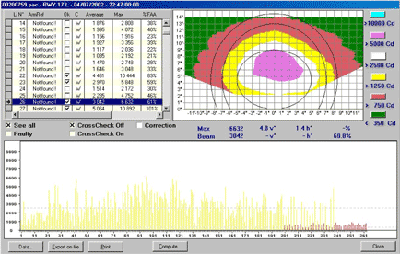| Mobile
Light Measurement of Airfield Lighting System
Commissioning
of New Installations and Preventive Maintenance
 Annex
14, Volume I, recommends regular measurements of light intensity
of Airfield Lighting Installations, at least twice a year
with a Civil Aviation Certified device.Since October 2003,
airports have to submit compliancy report of their installations
against the ICAO standards. (Amendment n°5 to Annex
14)This officialises the requirement for a Preventive Maintenance
System for Airfield Lighting that meets the safety regulations.
It has to be regularly monitored to ensure that it meets
ICAO standards. Annex
14, Volume I, recommends regular measurements of light intensity
of Airfield Lighting Installations, at least twice a year
with a Civil Aviation Certified device.Since October 2003,
airports have to submit compliancy report of their installations
against the ICAO standards. (Amendment n°5 to Annex
14)This officialises the requirement for a Preventive Maintenance
System for Airfield Lighting that meets the safety regulations.
It has to be regularly monitored to ensure that it meets
ICAO standards.
Optimising
maintenance works and stocks
PAC is a mobile system for evaluating all inset and elevated
lights. The test report provides the candela value of each
light, and identifies any defect requiring action to be
taken. It also makes it possible to monitor lamp ageing
from previous runs so that all the results for a runway
or taxiway can be compared.
This enables the airfield lighting department to plan its
operations and manage its stocks as efficiently as possible.
If the lamp is not defective although the system indicates
a low intensity, the identification facility guides the
search and thus optimises maintenance operations >back
to top
Operation
of the PAC system
The system is installed on the front of a standard vehicle.
Measurements are made in real time as the vehicle travels
over the lights at a speed up to60km/h.
The luminous intensity detected is fed to a data processing
program which stores and processes several thousand values
for each light.This technique provides the average intensity
of the main beam in candelas, its maximum intensity, as
well as the colour and elevation settings of the lights.PAC
can be used to evaluate any light source shining on its
surface giving an illumination of more than 10 lux.
>back to top
Alignment
Control
In order to ensure the best alignment, the driver looks
at a video monitor fed by a camera fitted on PAC strip.
Certification and calibration
Each unit manufactured by FB Technology is calibrated and
certified on the basis of a specification drawn up by the
S.T.N.A. >back to top
Certification
and calibration
In order to ensure the best alignment, the driver makes
sure that each unit manufactured by FB Technology is calibrated
and certified on the basis of a specification drawn by the
S.T.N.A.
Technical
data
Description of the supply:
The system is supplied in a carrying case :
1• The measurement strip
2• The electronic processing interface box
3• The distance measurement device
4• The PAC software installed on a PC. >back
to top
Installation:
The system can be installed on any vehicle.The customer
can have this done byFB Technology or can do it himself,
in which case he must have his installation checked by a
FB Technology engineer.The distance measuring device is
mounted on the side of the vehicle.The electronic unit is
enclosed in a protective carrying case and fitted in the
vehicle.
Operation
conditions:
Operation by night:
up to 60 km/h Measurement range
Displacement speed:
up to 30.000 candelas >back
to top
Options
BETA (dgps) : Identification of each light fitting with
geographical co-ordinates
Guarantee
and calibration
The system is supplied with a full 1-year guarantee.After
the guarantee period, a maintenance contract is required
to cover yearly calibration and software updates.

Fitting
Id., elevation, maximum and minimum average, isocandela
diagram.
|

